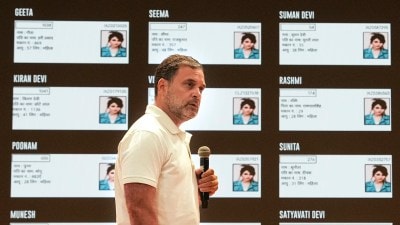2009 to 2021: In Mumbai, lung cancer deaths see rise by 49%
In 2009, 621 people died from lung cancer in Mumbai, a figure that has gradually risen over the years. In 2021, there were 923 lung cancer deaths in the city, a 48.6 per cent jump in the 12-year period.
 While 683 people died from lung cancer in 2010, there were 724 deaths in 2012, 904 (2015), 964 (2016) and 942 (2017). (Representational/Getty Images)
While 683 people died from lung cancer in 2010, there were 724 deaths in 2012, 904 (2015), 964 (2016) and 942 (2017). (Representational/Getty Images) Lung cancer deaths rose by nearly 49 per cent in Mumbai between 2009 and 2021. The jump is significant and doctors cite carcinogenic risk due to long exposure to air pollution especially PM2.5, tobacco consumption and improved death certification procedures behind the sharp increase in lung cancer deaths.
In 2009, 621 people died from lung cancer in Mumbai, a figure that has gradually risen over the years. In 2021, there were 923 lung cancer deaths in the city, a 48.6 per cent jump in the 12-year period.
While 683 people died from lung cancer in 2010, there were 724 deaths in 2012, 904 (2015), 964 (2016) and 942 (2017). The year 2018 recorded the highest number of cases at 1,006 in the 12-year period. In 2020, the first year of Covid-19, however, deaths from lung cancer in Mumbai fell to 802.
The data on lung cancer deaths in Mumbai was obtained from the Brihanmumbai Municipal Corporation (BMC) through an RTI application filed by Shaikh Faiyaz Alam, president of NGO Govandi New Sangam Welfare Society. The data for 2022 is not available yet.
An analysis of the data shows that between 2016 and 2021, most deaths were reported from F-South ward that covers areas around the King Edward Memorial (KEM) Hospital in Parel — the biggest civic-run hospital in Mumbai. “Since 2016, deaths are recorded at the place of occurrence. So, as KEM witnesses a high footfall of patients and subsequent deaths, the ward records the most deaths,” said an official from the civic health department.
Health experts say increased exposure to tobacco, air pollution and enhanced diagnostic techniques have led to more people being diagnosed with lung cancer in Mumbai over the last decade.
Indeed, Mumbai has witnessed a rise in pollution levels over the last few years and, over the last one month, the air pollution levels are even higher than in Delhi. Last week, on most days Mumbai reported ‘very poor’ air quality.
Several reports globally have linked air pollutants to lung cancer. Dr Sarthak Rastogi, Consultant Pulmonologist at SL Raheja Hospital, explained that PM2.5 can trigger the already existing mutation in the normal cell to become cancerous. Areas with higher air pollution levels have a higher incidence of non-smokers developing lung cancer compared to areas with lower pollution levels. “In the last decade, we have seen more patients developing lung cancer, especially women who are non-smokers. In the UK, one in 10 cases of lung cancer is due to air pollution,” he said.
Dr Sewanti Limaye, director of oncology and precision medicine at Sir HN Reliance Hospital, said that a recent research covering nearly 45,000 people in the UK found that large dust particles over 2.5 µm in size could lead to a specific type of lung cancer caused by a mutation in the EGFR gene. She explained, “This is seen in 25 per cent of lung cancers in India and makes up the highest proportion of lung cancer seen in non-smokers. Dr Charles Swanton from Francis Crick Institute in the UK in his research presentation demonstrated that this was a unique mechanism different from the tobacco-related carcinogenesis that is so widely known. This mechanism of carcinogenesis was dependent on particulate matter size of over 2.5 µm and provided enough evidence to wage a war against air pollution to limit cancer causation in non-smokers.”
In recent years, cigarette smoking has gone up among men and women. India continues to be the second highest tobacco consumer in the world, with roughly 10.7 per cent of its population above 15 years consuming cigarettes or beedi as per Global Adult Tobacco Survey 2016-17. This can also be a contributing factor in the rise in deaths from lung cancer.
Dr Rastogi explained that tobacco smokers are up to 30 times at higher risk of lung cancer compared to a non-smoker. Tobacco use, barring a few states like Sikkim, Goa, Mizoram, Gujarat, Bihar and Himachal Pradesh, has been declining in India as per National Family Health Survey (NFHS) 2019-20 data, but it is already at an epic proportion with 28 per cent of the population consuming tobacco in any form. “Tobacco consumption in any form is responsible for 27 per cent of all cancers and is responsible for 1.2 million deaths annually,” he said.
“The effects of smoking often manifest after years of exposure, and we are possibly seeing the effects of the boom in smoking a few decades ago. India continues to be the second largest consumer of tobacco in the world, and the trend of increased incidence of lung cancer is likely going to get worse with time,” said Dr Lancelot Pinto, epidemiologist and pulmonologist at Hinduja hospital.
However, doctors also highlighted that the advancement of science and technology has also helped in better identification and classification of deaths which was restricted earlier. “The widespread availability of CT scans and newer drugs for lung cancer could lead to people with the disease getting detected at an earlier stage and living longer. This would lead to an increase in numbers of lung cancer deaths too. Earlier, individuals who died from cancer that was undiagnosed at the time of death were not certified as death from lung cancer,” added Dr Pinto.
It is estimated that 14.6 lakh people were affected by cancer in India in 2022. Lung and breast cancers were the leading types of cancer in men and women, respectively.







